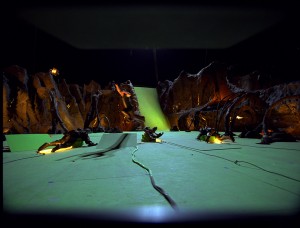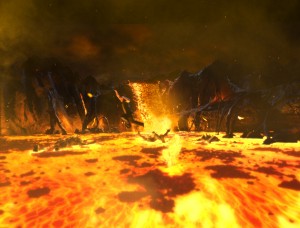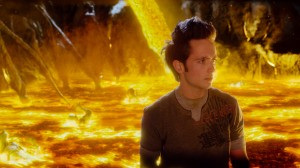Ian Failes returns to fxguide and in this his first new interview he speaks with co-visual effects supervisors Chad Wiebe and Mike Shand of Frantic films about the lava lake and final battle sequences in the new Dragonball: Evolution.
fxg: Chad, could you give me an overview of Frantic Film ‘s work for the film?
Chad Wiebe : We handled about 340 shots for the film. We started out at the shoot in Durango, Mexico. I flew down there to work with Ariel Velasco-Shaw, the visual effects supervisor, to oversee some of the sequences we were working on. The main sequence we were awarded was the lava lake sequence, which is where Goku fights the Fulum assassins and tries to get one of the dragonballs. Through the course of events, we ended up getting a fairly substantial second award about half way through production, which was the final confrontation sequence.
So after the shoot in Durango, we came back to Vancouver and started working on it. Then production went into hiatus for a few months while they decided on the look they wanted for the film. We ended up doing a fairly substantial amount of look development which encompassed everything from different colour treatments of the plates to complete background replacements in comic book style in the realm of Sin City.
We spent about a month doing look-dev for the studio to help give them a sense of where they wanted to take the visual effects, as well as the overall look of the film. Once that was done and they had a look locked off, we got back into the VFX and that’s how we got the second sequence, and that’s where Mike Shand and his team in Winnipeg stepped in.
fxg: Did you look to the current Dragonball world to work out the look for the film?
Chad Wiebe : Yes, definitely. We fell back on the original cartoons and the comic books for reference and a lot of the looks we were doing. I wouldn’t say it was something that we were trying to perfectly match but we did use it as a guide. We touched on the original comic books and also graphic novel looks. In the end we didn’t go in one full direction but just added hints of it here and there and went for a fairly unique look that wasn’t 100% specific to any one sort of style.
fxg: It seemed like quite a world effort to co-ordinate the facilities involved, including Frantic facilities. Can you talk about how you managed that?
Chad Wiebe : With the hiatus, there had to be a shuffle with some of the vendors working on the show so the opportunity arose for us to take on a substantial amount of additional work. That’s when our award quadrupled in size. We had a Winnipeg crew, with Mike supervising, we had our LA department working on a few sequences, as well as our matte painting crew, led by Ken Nakada. We tried to break it up sequentially so that one office would do one sequence and another office another sequence, so there wasn’t too much of a break or disconnect between the offices. It worked pretty well in that regard being able to keep the supervision to the one area.

fxg: Can you talk about the digital character shots in the lava lake sequence?
Chad Wiebe : In the movie, they’re tracking down the dragonballs and one of them ends up in the lava lake. Piccolo, the bad guy, has created these creatures called the Fullum assassins. He creates them through the use of his own blood and they have the ability to re-generate. So if you chop one in half, it’ll grow back into two creatures, which made them seemingly indestructible. However, they find that they can actually kill them by throwing them into the lava. So, our sequence had two aspects – the battle with the Fullum assassins and chopping them up and realising they grow back, and the other aspect is getting them into the lava, which is where we had a lot of fluid dynamics work.
We received a cyberscan of the actors in costume. It wasn’t a fully digital character. We used that in the fight sequences when they wanted the Fullum to do anything that wasn’t possible by the actor, and when they get chopped up. So we used the scan as a starting point to re-build a digital version of the actors. In our digital version, we broke it up into a couple of different areas. One of them was a muscle pass, a musculature of the characters. They also had an outer exo-skeleton which was a rockish-like material that provided them with some armour. We built that layer as a secondary element, so that when they re-grow it starts out with this gelatinous muscle tissue that starts bubbling up like a cauldron of hot oil. It bubbles up until it eventually forms their muscle shape. From there, the exo-skeleton grows on top.

We had a few sequences where there are fully digital characters interacting with the real characters. In some shots there might have been one digital character next to a real actor in the Fullum suit. For shots like that, the lighting and rendering had to be spot on so there wasn’t any visible discrepancy between the digital characters and the ones they actually shot.
From there, it was all about lava, fluid dynamics, interaction with the characters and creating a lava lake environment. They had built a set that had a green surface painted on it so we could replace the lava surface as well as a lava falls that feed all the lava into the lake. After we saw a few of the shots, the lack of scale of the shots was quite apparent. It just didn’t seem as menacing or as majestic and I guess they’d hoped. So, in addition to adding lava to the plates, we ended up breaking off some of the set pieces, expand it up pretty substantially and then blended it digitally to create a lava lake that appeared to be almost twice as big as it was on set.
fxg: What sort of tools did you use to create the lava?
Chad Wiebe : We used some proprietary software here called Flood. We’ve been developing it over the years, having used it on other shows in the past. For this show in particular, we developed a bunch of particular tools to facilitate what we needed. This included viscosity controls and full interaction capabilities. We probably had two or three different builds of it that did specific fluid sims that we could mesh together. You could have splashes with more large scale sims, for example. There’s quite a few different parts to it. Overally, it was pretty big endeavour for our R&D team, but they came up with some cool tools to help us sell the shots. We used it with 3ds Max. All the tools are written around that platform, but it’s completely proprietary, so we write our own tools and then we just integrate them in 3ds Max, which all our artists use.
fxg: Mike, you supervised the final fight sequence, can you tell me about your work for that?
Mike Shand : We got that work because the lava lake was proceeding rather well. That sequence was carried out primarily in Winnipeg. It was about 200 shots and it’s the entire conflict from when they arrive at the Dragon Temple to Goku knocking out Piccolo. We did a large amount of set extensions with an asset of the Temple originally created by Hybride which we modified and enhanced for our own purposes. And we also did all the energy effects in that sequence. We based our energy effects initially on looks that were established by Hybride, and then pushed them further. In our sequence it’s an all out energy fight whereas previously the energy effects are seen as ‘training’ versions. We were able to open it up and get a bit crazier with the particle effects at the end.
fxg: How did you accomplish the set extensions?
Mike Shand : Goku and Piccolo were on wires flying around punching each other and everything. We tracked those plates, put in our digital temple and also sky replacements. We did a bunch of matte paintings for the skies. Over the course of the sequence, the environment is supposed to change from pre-eclipse to post-eclipse, so there were two distinct looks. The pre-eclipse was a more sunsetty, warmer, apprehensive atmosphere and the eclipse was an other-wordly, green, fantastical atmosphere.
Other things we did were the flying Hummer for the approach to the Temple and the environment outside the Temple. That was all CG. Originally it was going to be done as matte paintings, but there were too many deep camera moves. So we did all that as a 3D set extension. The Hummer asset was provided by Hybride that they had built, and we dialed in the animation and particle effects for it and of course the compositing.
fxg: How were the energy effects achieved?
Mike Shand : We did the energy effects for anything Goku throws, his Kamehameha and regular attacks. We also did the particle effects for the Mafuba which Roshi throws. The energy effects were done with FumeFX simulations, rendered in our Krakatoa particle renderer, so we were able to get a very liquidy looking effect.

fxg: Do you have a favourite shot from the film?
Chad Wiebe : For me it was this one shot where Goku crossed the lava lake. When they learn that the way to kill the Fullum is to throw them into the lava lake, they decided the best way to get across the lake was to throw as many Fullum in as they can and make a bridge. In one shot we have Goku on one side of the lake and then he has to jump on the Fullum as stepping stones to cover the entire distance. We have a low angle showing the entire lava lake with our lava falls in the background and the Fullum assassins sizzling in the lava. They had big maquettes they used for the Fullum on set, but we made digital versions so we could pose them how we wanted to make them look a lot cooler as he’s jumping over. Overall, it’s a pretty majestic shot with a fully digital matte painting, fully simulated lava falls, our digital characters laid out and Goku jumping. It’s quite an interesting shot and basically took everything we put in the movie and combined it into one.
Mike Shand : We had so much fun doing the energy fights – everyone in visual effects wants to do those types of shots. The final blast and Goku’s final Kamehameha are brilliant. We also got to change how they were presented in respect of the source plate. For a couple of them we went all CG and came up with more dynamic moves. One of them is the quarter angles shot of Goku rising up in the air with the two beams colliding in front of him. I think that’s my favourite shot.
fxg: Dragonball seems like a film that lends itself well to visual effects. Did that mean you had to restrain yourself from going all out, or did that let you go all out?
Mike Shand : I had just come off some pretty big technical shows with rules and continuity, so Dragonball was a really nice break. Ariel gave us the space to come up with great looks, he’d say, ‘C’mon, challenge me’. It was a lot of fun. I think this is the kind of movie that would get you into visual effects, if you’re a kid. It was so much fun trying to find what the limit was, you know, what is over the top? That being said, there was a ceiling. A lot of the fans wanted Goku to blow up a mountain or something like that. We had to find a ceiling, because he’s just starting out. This movie is an introduction to the Dragonball world and this is him just discovering his powers. So we had to find a way to show a ‘wow’ moment but at the same time not go too far. That was the challenge for us.
Chad Wiebe : Ariel definitely gave us that creative freedom. It was great because you really get to feel you’re owning the stuff you’re working on and that just makes you want to make it look as cool as you possibly can. It was definitely one of the more fun shows I’ve worked on in a creative way.
